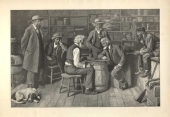The Checker Maven
The World's Most Widely Read Checkers and Draughts Publication
Bob Newell, Editor-in-Chief
Published every Saturday morning in Honolulu, Hawai`i
Noticing missing images? An explanation is here.
And The Winner Is ...

This column will appear just after the U.S. Presidential election, but the time of writing (eight weeks in advance of publication), the polls made it too close to call, so we can't even guess who won.
But that lead us to the idea of publishing one of those highly irritating "What Result?" problems (but not even close to matching the irritation caused by the just-concluded political season).
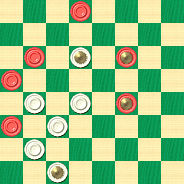
WHITE
White to Play, What Result?
W:WK30,25,22,18,17,K10:B21,K19,13,K11,9,2.
Were you able to call the election? Can you find the result of this problem, and identify one candidate with White and one with Black?
Give it a go and then click on Read More. We think you'll find the solution both satisfying and appropriate.![]()
Get Out and Vote


In the United States, the Tuesday after this column appears is election day and Hillary and Donald are going head to head with the White House as the prize. We're writing this column some weeks in advance, so we don't know the current state of the polls, but we can safely say that this is the most, um, unique presidential election in many a year.
We urge you to get out and vote for the candidates of your choice. The right to vote is also a responsibility. Please do cast your ballot as your conscience dictates.
In checkers, going "head to head" over the board can also be quite a contest, although even as checker enthusiasts we have to admit that the stakes are somewhat lower, thankfully, than those in a Presidential election. No polls, no talking heads doing endless analysis of incredibly fine points, and, hopefully, no rancor, but instead just the enjoyment of the game.
Here's an actual "head to head" game, played long ago by Berry Mitchell and Chas. Hefter. (The actual players are not depicted below.)
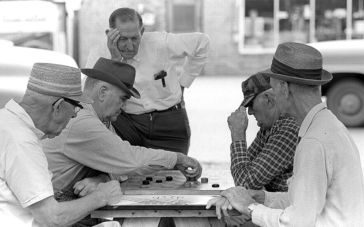
| 1. | 11-15 | 23-19 |
| 2. | 8-11 | 22-17 |
| 3. | 4-8 | 17-13 |
| 4. | 15-18 | 24-20 |
| 5. | 10-15 |
11-15 is better; White now gets an edge.
| 5. | ... | 19-10 |
| 6. | 7-14 |
6-15 may be the better choice of jumps.
| 6. | ... | 26-23 |
| 7. | 11-15 | 28-24 |
| 8. | 8-11 |
Loses. 2-7 is correct.
| 8. | ... | 30-26 |
| 9. | 2-7 |
6-10 is better; Black's situation is now even worse.
| 9. | ... | 26-22 |
| 10. | 3-8 | 23-19 |
| 11. | 7-10 |
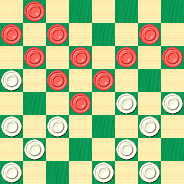
WHITE
White to Play and Win
W:W32,31,29,27,25,24,22,21,20,19,13:B18,15,14,12,11,10,9,8,6,5,1.
The win isn't terribly hard to find; would it be that all the problems the next President will face were as easy! Elect your best line of play and then vote with your mouse on Read More to verify your solution.![]()
The Leaves Fall Quickly

In the autumn, the leaves can fall quickly. In the photo above, Junior is having a great time with the autumn leaves. Dad may have somewhat less fun when it comes time to bundle them up and dispose of them.
Quickly falling leaves inspire one of the easiest speed problems we've published in a while. Of course, you know the catch; you'd better be quick because we're only giving you five seconds.
Click on the link below to display the position and start the clock. Then, quick as can be, come back and rake your mouse on Read More to check your solution.
October Speed Problem (very easy, 5 seconds)
![]()
More Than One Way To Do It

"There's more than one way to do it" is a common enough phrase, and it seems to have gotten attached to the scripting language Perl, due to Perl's extreme (some say excessive) flexibility. At The Checker Maven Perl scripts figure prominently in our computer work, and, even though the modern trend is more towards the Python language, we persist. But that discussion is even further off-topic.
Today's problem, submitted by regular contributors Lloyd and Josh Gordon of Toronto has two main solutions, hence "more than one way to do it." One of the solutions occurred in over the board play, while the other, which is quite different, is due to KingsRow computer analysis.
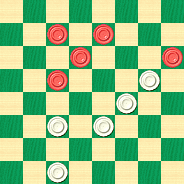
WHITE
White to Play and Win
W:W30,23,22,19,16:B14,12,10,7,6.
Which solution will you find? Can you see them both? To find out, there's only one way to do it: click on Read More.![]()
Labor Day Salute

Labor Day; it's a welcome day off work, a last hurrah for summer in North America, a time to see a parade, or squeeze in one more barbecue or picnic or camping trip before the leaves fall and the nights become chill.
And, as we point out each year, it's a time to show our respect for the average Jane and Joe that make up America's workforce, those honest, decent, hard-working people who show up every day, do their jobs, and help make America what it is. There was a time when checkers was their game, and although that's less of a truism today, checkers remains democratic, accessible, and suitable for everyone.
On holidays like these, we like to feature great American players and problemists. Today we have one of the few problems authored by one of the greatest American checkerists of all time, Samuel Gonotsky. It is based on actual over the board play.
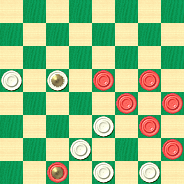
WHITE
White to Play and Draw
W:W32,31,26,23,K14,13:BK30,28,24,20,19,16,15.
White is a man down but has mobility advantages. Can the situation be turned into a draw? Labor away at this one; but seeing the solution is hardly laborious and requires only a mouse click on Read More.![]()
Don't be a Square

"Don't be a square" is probably an expression you haven't heard much lately, as it's long out of date. It actually originated with jazz musicians but by the 1980s, it was starting to sound old-fashioned.
Our use of this phrase to title our column is for two reasons. The first is the shape seen in the problem diagram.
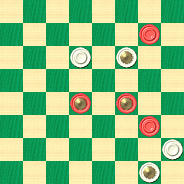
BLACK
Black to Play and Win
B:W23,K22,5,K1:B25,K15,K14,9.
The second meaning derives from the solution itself. You might see what we're getting at when you solve it. It's not overly difficult. Don't be a square--- try to work it out. When you're finished, click your mouse squarely on Read More to see the solution and an explanation.![]()
Delicado

Your editor, many years ago, went hiking and climbing in southern Mindanao in the Philippines. Locals referred to the area where we went as "delicado" --- delicate --- due to the sometime presence of rebel militia. Being young and foolish, we were not deterred from what turned out to be a dangerous undertaking. Fortunately, nothing went wrong.
Today's checker problem is "delicado" in a different way, and there's nothing foolish or dangerous about it at all. Your solution may go wrong, but if you work at it, you'll get it, and you may learn some technique in the process.
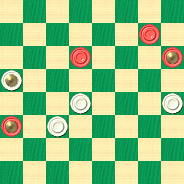
WHITE
White to Play and Draw
W:W22,20,18,K13:BK21,K12,10,8.
There's no need to carry arms or keep a lookout, and checking your solution is as easy as clicking on Read More.![]()
August Heat
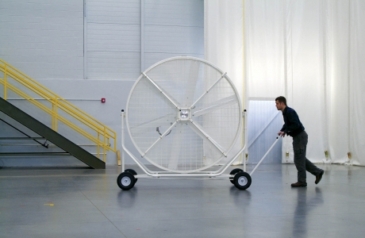
August in the Northern Hemisphere can be pretty darn hot. Sometimes extraordinary measures are required, as shown in the photo above.
Your editor is scheduled to be visiting in far off New York City on the date this column is due to be published, and August in New York is just about always hot and humid.
So we picked out a rather hot stroke problem (please, no heat stroke jokes) for this month. It looks complex but it's actually one of the easier ones, and it's filled with action.
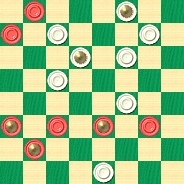
WHITE
White to Play and Win
W:W31,19,14,11,K10,8,6,K3:BK25,24,K23,22,K21,5,1.
Don't overheat your brain; you'll see the solution if you can visualize well (just keep the sweat out of your eyes). When you've solved it, click on Read More to see the solution.![]()
Brooklynite
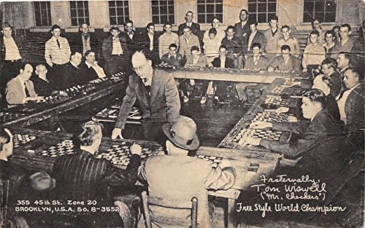
We came across this personalized postcard evidently made for checker great Tommie Wiswell. Mr. Wiswell is playing a simultaneous exhibition, as he often did. Note that the postcard lists what was apparently his home address, 355 45th Street in Brooklyn, a building that is still standing. Our research tells us it's in the Sunset Park section of Brooklyn, was built in 1910 (interestingly, the year Mr. Wiswell was born); it's listed as a multiple family dwelling; the size is about 2,500 square feet on a 2,000 square foot lot; and it's valued at around $800,000 or so.
We'll use any excuse to feature a Tommie Wiswell problem, of course. This one is based on a Louis Ginsberg game played at an unspecified club in New York City. Mr. Ginsberg was also a Brooklynite, and hence comes the title of the problem.
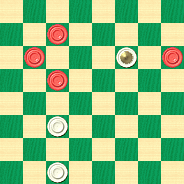
WHITE
White to Play and Draw
W:W30,22,K11:B14,12,9,6.
The problem isn't all that easy in that there are some nice ways to get it wrong. It would be a lot of fun to work on it at a nearby Brooklyn park, but in this internet age, you can solve it from just about anywhere in the world. Give it a try and then click on Read More to see the solution, notes, and an interesting photo.![]()
Man in the Middle

"Man in the middle" can have several meanings. In the computer security world, it refers to a cyberattack based on intercepting--- getting in the middle of--- a network path. In the baseball example shown above, the baserunner is caught between bases. In general, being "the man in the middle" isn't a very good thing.
Not so in today's checker problem, which is credited to old-time checkerist D. Robinson of Glasgow. Let's have a look.
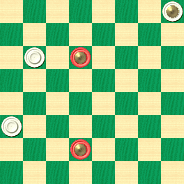
BLACK
Black to Play and Draw
B:WK29,24,12:BK23,K7.
Black has two men in the middle (actually, two kings). But the title of our problem is "man" in the middle, not "men." That's a bit of a hint toward finding a somewhat surprising draw for Black.
Can you solve it, or will you get caught in the middle? Click your mouse (the left button, not the middle one) on Read More when you're ready to check your solution.![]()
The Checker Maven is produced at editorial offices in Honolulu, Hawai`i, as a completely non-commercial public service from which no income is obtained or sought. Original material is Copyright © 2004-2026 Avi Gobbler Publishing. Other material is public domain, AI generated, as attributed, or licensed under CC1, CC2, CC3 or CC4. Information presented on this site is offered as-is, at no cost, and bears no express or implied warranty as to accuracy or usability. You agree that you use such information entirely at your own risk. No liabilities of any kind under any legal theory whatsoever are accepted. The Checker Maven is dedicated to the memory of Mr. Bob Newell, Sr.

